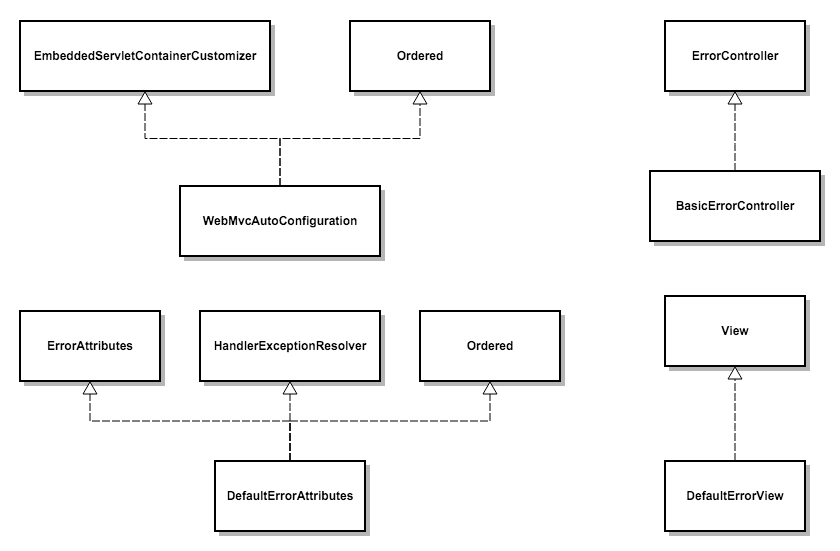在Spring MVC异常处理详解中,介绍了Spring MVC的异常处理体系,本文将讲解在此基础上Spring Boot为我们做了哪些工作。下图列出了Spring Boot中跟MVC异常处理相关的类。

Spring Boot在启动过程中会根据当前环境进行AutoConfiguration,其中跟MVC错误处理相关的配置内容,在ErrorMvcAutoConfiguration这个类中。以下会分块介绍这个类里面的配置。
在Servlet容器中添加了一个默认的错误页面
因为ErrorMvcAutoConfiguration类实现了EmbeddedServletContainerCustomizer接口,所以可以通过override customize方法来定制Servlet容器。以下代码摘自ErrorMvcAutoConfiguration:
@Value("${error.path:/error}")
private String errorPath = "/error";
@Override
public void customize(ConfigurableEmbeddedServletContainer container) {
container.addErrorPages(new ErrorPage(this.properties.getServletPrefix()
+ this.errorPath));
}
可以看到ErrorMvcAutoConfiguration在容器中,添加了一个错误页面/error。因为这项配置的存在,如果Spring MVC在处理过程抛出异常到Servlet容器,容器会定向到这个错误页面/error。
那么我们有什么可以配置的呢?
- 我们可以配置错误页面的url,/error是默认值,我们可以再application.properties中通过设置error.path的值来配置该页面的url;
- 我们可以提供一个自定义的EmbeddedServletContainerCustomizer,添加更多的错误页面,比如对不同的http status code,使用不同的错误处理页面。就像下面这段代码一样:
@Bean
public EmbeddedServletContainerCustomizer containerCustomizer() {
return new EmbeddedServletContainerCustomizer() {
@Override
public void customize(ConfigurableEmbeddedServletContainer container) {
container.addErrorPages(new ErrorPage(HttpStatus.NOT_FOUND, "/404"));
container.addErrorPages(new ErrorPage(HttpStatus.INTERNAL_SERVER_ERROR, "/500"));
}
};
}
定义了ErrorAttributes接口,并默认配置了一个DefaultErrorAttributes Bean
以下代码摘自ErrorMvcAutoConfiguration:
@Bean
@ConditionalOnMissingBean(value = ErrorAttributes.class, search = SearchStrategy.CURRENT)
public DefaultErrorAttributes errorAttributes() {
return new DefaultErrorAttributes();
}
以下代码摘自DefaultErrorAttributes, ErrorAttributes, HandlerExceptionResolver:
@Order(Ordered.HIGHEST_PRECEDENCE)
public class DefaultErrorAttributes implements ErrorAttributes, HandlerExceptionResolver,
Ordered {
//篇幅原因,忽略类的实现代码。
}
public interface ErrorAttributes {
public Map<String, Object> getErrorAttributes(RequestAttributes requestAttributes,
boolean includeStackTrace);
public Throwable getError(RequestAttributes requestAttributes);
}
public interface HandlerExceptionResolver {
ModelAndView resolveException(
HttpServletRequest request, HttpServletResponse response, Object handler, Exception ex);
}
这个DefaultErrorAttributes有什么用呢?主要有两个作用:
- 实现了ErrorAttributes接口,具备提供Error Attributes的能力,当处理/error错误页面时,需要从该bean中读取错误信息以供返回;
- 实现了HandlerExceptionResolver接口并具有最高优先级,即DispatcherServlet在doDispatch过程中有异常抛出时,先由DefaultErrorAttributes处理。从下面代码中可以发现,DefaultErrorAttributes在处理过程中,是讲ErrorAttributes保存到了request中。事实上,这是DefaultErrorAttributes能够在后面返回Error Attributes的原因,实现HandlerExceptionResolver接口,是DefaultErrorAttributes实现ErrorAttributes接口的手段。
@Override
public ModelAndView resolveException(HttpServletRequest request,
HttpServletResponse response, Object handler, Exception ex) {
storeErrorAttributes(request, ex);
return null;
}
我们有什么可以配置的呢?
1、我们可以继承DefaultErrorAttributes,修改Error Attributes,比如下面这段代码,去掉了默认存在的error和exception这两个字段,以隐藏敏感信息。
@Bean
public DefaultErrorAttributes errorAttributes() {
return new DefaultErrorAttributes() {
@Override
public Map<String, Object> getErrorAttributes (RequestAttributes requestAttributes,
boolean includeStackTrace){
Map<String, Object> errorAttributes = super.getErrorAttributes(requestAttributes, includeStackTrace);
errorAttributes.remove("error");
errorAttributes.remove("exception");
return errorAttributes;
}
};
}
- 我们可以自己实现ErrorAttributes接口,实现自己的Error Attributes方案, 只要配置一个类型为ErrorAttributes的bean,默认的DefaultErrorAttributes就不会被配置。
提供并配置了ErrorController和ErrorView
ErrorController和ErrorView提供了对错误页面/error的支持。ErrorMvcAutoConfiguration默认配置了BasicErrorController和WhiteLabelErrorView,以下代码摘自ErrorMvcAutoConfiguration:
@Bean
@ConditionalOnMissingBean(value = ErrorController.class, search = SearchStrategy.CURRENT)
public BasicErrorController basicErrorController(ErrorAttributes errorAttributes) {
return new BasicErrorController(errorAttributes);
}
@Configuration
@ConditionalOnProperty(prefix = "error.whitelabel", name = "enabled", matchIfMissing = true)
@Conditional(ErrorTemplateMissingCondition.class)
protected static class WhitelabelErrorViewConfiguration {
private final SpelView defaultErrorView = new SpelView(
"<html><body><h1>Whitelabel Error Page</h1>"
+ "<p>This application has no explicit mapping for /error, so you are seeing this as a fallback.</p>"
+ "<div id='created'>${timestamp}</div>"
+ "<div>There was an unexpected error (type=${error}, status=${status}).</div>"
+ "<div>${message}</div></body></html>");
@Bean(name = "error")
@ConditionalOnMissingBean(name = "error")
public View defaultErrorView() {
return this.defaultErrorView;
}
// If the user adds @EnableWebMvc then the bean name view resolver from
// WebMvcAutoConfiguration disappears, so add it back in to avoid disappointment.
@Bean
@ConditionalOnMissingBean(BeanNameViewResolver.class)
public BeanNameViewResolver beanNameViewResolver() {
BeanNameViewResolver resolver = new BeanNameViewResolver();
resolver.setOrder(Ordered.LOWEST_PRECEDENCE - 10);
return resolver;
}
}
ErrorController根据Accept头的内容,输出不同格式的错误响应。比如针对浏览器的请求生成html页面,针对其它请求生成json格式的返回。代码如下:
@RequestMapping(value = "${error.path:/error}", produces = "text/html")
public ModelAndView errorHtml(HttpServletRequest request) {
return new ModelAndView("error", getErrorAttributes(request, false));
}
@RequestMapping(value = "${error.path:/error}")
@ResponseBody
public ResponseEntity<Map<String, Object>> error(HttpServletRequest request) {
Map<String, Object> body = getErrorAttributes(request, getTraceParameter(request));
HttpStatus status = getStatus(request);
return new ResponseEntity<Map<String, Object>>(body, status);
}
WhitelabelErrorView则提供了一个默认的白板错误页面。
我们有什么可以配置的呢?
- 我们可以提供自己的名字为error的view,以替换掉默认的白板页面,提供自己想要的样式。
- 我们可以继承BasicErrorController或者干脆自己实现ErrorController接口,用来响应/error这个错误页面请求,可以提供更多类型的错误格式等。
总结
Spring Boot提供了默认的统一错误页面,这是Spring MVC没有提供的。在理解了Spring Boot提供的错误处理相关内容之后,我们可以方便的定义自己的错误返回的格式和内容。不过,如果要实现统一的REST API接口的出错响应,就如这篇文章里的这样,还是要做不少工作的。